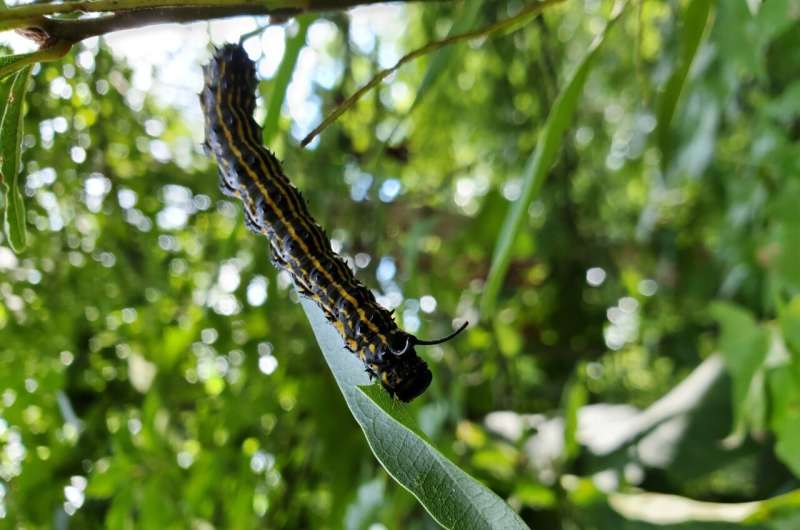Blood clotting is a fundamental process in maintaining hemostasis and preventing excessive bleeding in vertebrates. However, the mechanisms underlying hemostasis in insects, such as caterpillars, have long remained a mystery due to their distinct physiology and composition of hemolymph, the insect equivalent of blood. In a groundbreaking study published in Frontiers in Soft Matter, researchers have unveiled the remarkable hemostatic abilities of tobacco hornworm caterpillars, shedding light on the intricate interplay between hemolymph properties, cellular processes, and wound healing. This article delves into the findings of this pioneering research and explores its potential implications for advancing medical treatments and hemostatic agents.
Understanding Caterpillar Hemostasis: Unlike vertebrate blood, which contains red blood cells, hemoglobin, and platelets, insect hemolymph lacks these components and instead comprises amoeba-like cells called hemocytes. Despite these differences, hemolymph clots rapidly outside the insect body to seal wounds and prevent excessive bleeding. The study focused on elucidating the mechanisms by which tobacco hornworm caterpillars achieve this rapid hemostasis, offering insights into the viscoelastic properties of hemolymph and the role of hemocytes in wound closure.
Experimental Techniques: To investigate caterpillar hemostasis, researchers developed innovative techniques to study the flow properties of hemolymph and observe wound sealing processes in real-time. By restraining individual caterpillars and creating controlled wounds, the researchers were able to capture the dynamic changes in hemolymph behavior and hemocyte aggregation using high-speed cameras and microscopy. These experiments provided unprecedented insights into the rapid transformation of hemolymph from a low-viscous liquid to a viscoelastic fluid upon contact with external stimuli.
Viscoelastic Properties of Hemolymph: The study revealed that within seconds of leaving the caterpillar’s body, hemolymph undergoes a dramatic change in viscosity, transitioning from a Newtonian fluid to a viscoelastic material. Similar to saliva, which exhibits viscoelastic behavior due to the presence of mucins, caterpillar hemolymph forms bridges and retracts back to the wound site, facilitating rapid wound closure. This unique property enables caterpillars to seal wounds within minutes, preventing further bleeding and reducing the risk of infection.
Role of Hemocytes in Hemostasis: Central to the hemostatic process in caterpillars is the aggregation of hemocytes at the wound site, forming a protective crust that seals the injury. Through advanced microscopy techniques, researchers observed the intricate cellular processes involved in hemocyte recruitment and crust formation, highlighting the critical role of hemocytes in wound healing. Moreover, comparative analysis across multiple insect species revealed distinct hemolymph responses to shear and stretching, emphasizing the importance of hemocyte-rich hemolymph in rapid hemostasis.
Implications for Medicine: The discovery of caterpillar hemostatic mechanisms holds promising implications for human medicine and the development of novel hemostatic agents. By understanding the underlying principles of rapid wound closure in caterpillars, researchers aim to design synthetic compounds or drugs that mimic the viscoelastic properties of hemolymph, effectively stopping bleeding and promoting faster wound healing in humans. Additionally, insights from this research may inspire innovative approaches to hemostasis and tissue engineering, offering new solutions for surgical procedures and trauma care.
Future Directions: As researchers continue to unravel the mysteries of insect hemostasis, future studies will focus on elucidating the biochemical pathways and genetic mechanisms underlying rapid wound closure in caterpillars. By leveraging advances in materials science, biotechnology, and genetic engineering, scientists aim to translate these findings into practical applications for clinical settings. Moreover, collaborative efforts between interdisciplinary teams will facilitate the development of next-generation hemostatic agents with enhanced efficacy and biocompatibility.
The study of caterpillar hemostasis represents a remarkable convergence of biology, materials science, and medicine, offering unprecedented insights into the mechanisms of wound closure and hemostasis in insects. Through meticulous experimentation and innovative techniques, researchers have uncovered the viscoelastic properties of caterpillar hemolymph and elucidated the pivotal role of hemocytes in rapid wound healing. By harnessing nature’s blueprint, scientists aspire to revolutionize hemostatic therapies and advance medical interventions for trauma and surgical care. As we unlock the secrets of caterpillar hemostasis, we embark on a journey towards transformative discoveries and innovative solutions for human health and well-being.
